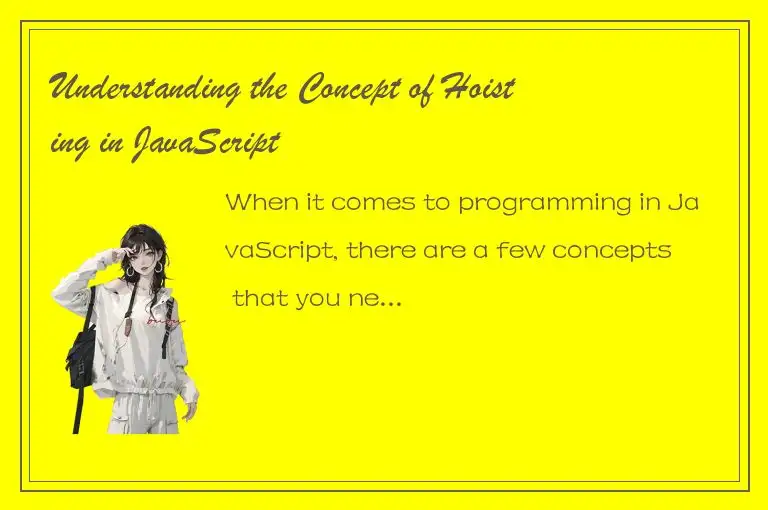When it comes to programming in JavaScript, there are a few concepts that you need to understand to write efficient and effective code. One of these concepts is "hoisting." Hoisting is a mechanism used in JavaScript that allows variables and functions to be used before they are declared. This may sound confusing at first, but once you understand how hoisting works, you can use it to your advantage to write better code.

What is Hoisting?
Hoisting is a mechanism that moves variable and function declarations to the top of their scope before the code is executed. This means that even if a variable declaration is placed at the bottom of the code, it will be moved to the top by the JavaScript engine before the code is executed. This process is called hoisting because it's like lifting up the declarations to the top of the code.
When a variable is hoisted, its declaration is moved to the top of its scope, but its assignment remains in place. This means that if you declare a variable at the bottom of your code and then assign it a value later on, the assignment will stay where it is. Here's an example:
```
console.log(name); // Output: undefined
var name = "John";
```
In this example, the variable `name` is declared at the bottom of the code, but it's still available to be used before its declaration due to hoisting. However, since we haven't assigned a value to the variable yet, its value is `undefined`.
How Does Hoisting Work?
Hoisting works by two different mechanisms: function hoisting and variable hoisting.
Function Hoisting
In JavaScript, functions are first-class citizens, which means they can be passed around and used like any other value. This is why function hoisting is a crucial part of hoisting in JavaScript. Function hoisting is where the declaration of the function is moved to the top of its scope, allowing the function to be called before it is declared.
Take a look at the following code:
```
foo(); // Output: "Hello World"
function foo() {
console.log("Hello World");
}
```
In this example, the `foo` function is called before it is declared. However, due to function hoisting, the declaration of the function is moved to the top of the scope, allowing it to be called before it's declared.
Variable Hoisting
Variable hoisting is where the declaration of the variable is moved to the top of its scope, allowing the variable to be used before it is declared. However, unlike function hoisting, the assignment of the variable remains in place.
For example, consider the following code:
```
console.log(name); // Output: undefined
var name = "John";
```
In this example, the declaration of `name` is moved to the top of its scope by variable hoisting, but the assignment of the variable remains in place. Therefore, at the point where the `console.log` is executed, `name` has been declared but not assigned a value, so its value is `undefined`.
Hoisting and Scoping
It's important to note that hoisting only affects the declaration of variables and functions, not their values. When a variable or function is declared, it's assigned to its scope, which determines where the variable or function is accessible. The scope is defined by the block in which the variable or function is declared.
For example, consider the following code:
```
function foo() {
var name = "John";
function bar() {
console.log(name); // Output: "John"
}
bar();
}
foo();
```
In this example, `name` is declared within the `foo` function, which means it's only accessible within the `foo` function and any functions declared within it, such as the `bar` function. When `bar` is called, it's able to access the `name` variable because it's within the scope of the `foo` function.
Best Practices for Using Hoisting
While hoisting can be a useful tool in JavaScript, it's important to use it properly to avoid any potential issues. Here are some best practices to follow when using hoisting in your code:
1. Declare variables and functions before using them.
Declaring variables and functions before using them will make your code easier to read and understand. It will also ensure that you don't run into any issues with hoisting.
2. Use strict mode.
Enabling strict mode in your code will help you catch any errors that occur due to hoisting. Strict mode will prevent undeclared variables from being created and will throw errors for any hoisting-related issues.
3. Avoid relying on hoisting.
While hoisting can be useful, relying too heavily on it can make your code hard to understand and maintain. Instead, try to write code that's easy to read and understand, and use hoisting sparingly when it's necessary.
Conclusion
Hoisting is an important concept in JavaScript that allows variables and functions to be used before they are declared. While this may sound confusing at first, understanding hoisting can help you write efficient and effective code. By following best practices for using hoisting, you can avoid any potential issues and ensure that your code is easy to read and maintain.




 QQ客服专员
QQ客服专员 电话客服专员
电话客服专员